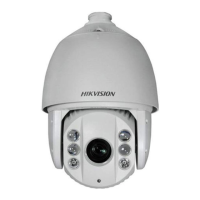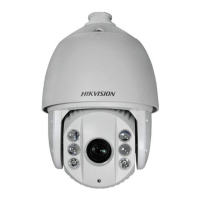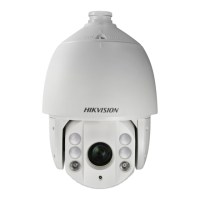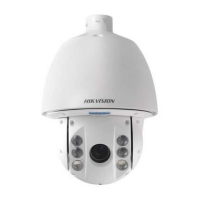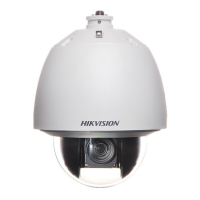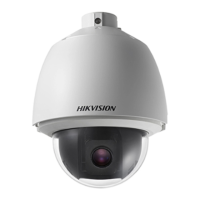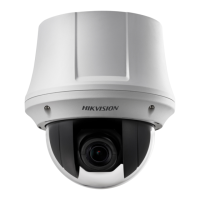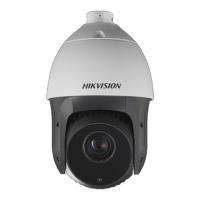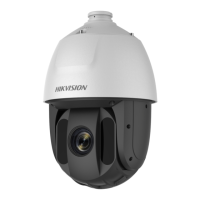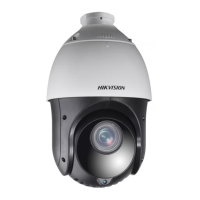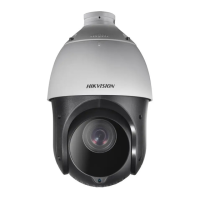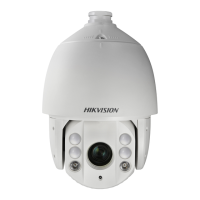
Do you have a question about the HIKVISION DS-2AE7232TI-A and is the answer not in the manual?
| Sensor type | CMOS |
|---|---|
| Progressive scan | Yes |
| Optical sensor size | 1/2.8 \ |
| Total megapixels | 2 MP |
| Gain control type | Auto/Manual |
| Maximum resolution | 1920 x 1080 pixels |
| Supported video modes | 1080p |
| Analog signal format system | NTSC, PAL |
| Form factor | Dome |
| Mounting type | Ceiling/wall |
| Product color | White |
| International Protection (IP) code | IP66 |
| Type | CCTV security camera |
| PTZ modes | 5 Pattern |
| PTZ protocols | Pelco-P/D |
| Languages support | English |
| Number of languages | 1 |
| Placement supported | Indoor & outdoor |
| Connectivity technology | Wired |
| Digital zoom | 16 x |
| Optical zoom | 32 x |
| Focal length range | 4.8 - 153 mm |
| Maximum aperture number | 4.6 |
| Minimum aperture number | 1.6 |
| Built-in HDD | No |
| LED type | IR |
| Night vision distance | 150 m |
| AC input voltage | 24 V |
| Power source type | AC |
| Power consumption (max) | 40 W |
| Pan range | 0 - 360 ° |
| Pan speed | 160 °/sec |
| Tilt angle range | -15 - 90 ° |
| Camera shutter speed | 1/10000 - 1 s |
| Minimum illumination | 0 lx |
| Interface | BNC |
| Operating temperature (T-T) | -30 - 65 °C |
| Height | 353.4 mm |
|---|---|
| Weight | 4500 g |
| Diameter | 220 mm |
Trademarks are properties of Hikvision and their respective owners.
Legal disclaimer regarding product use and liability, limiting Hikvision's responsibility.
Information on contacting local dealers for questions or requests.
Attention regarding modifications and compliance with FCC rules.
Equipment tested and found compliant with FCC Class A digital device limits.
Conditions for device compliance with FCC rules, preventing interference.
Product compliance with EU directives like Low Voltage, EMC, and RoHS.
Safeguards to prevent serious injury or death if neglected.
Precautions to prevent potential injury or material damage if neglected.
Overview of the speed dome's integrated pan/tilt unit and performance.
Lists various functions like Coaxial Control, HD Output, Limits, etc.
Describes the speed dome's self-test sequence upon power-up.
Explains basic controls like Panning, Tilting, Zooming, Focusing, and Iris.
Lists system-defined presets with special functions, not editable.
Describes various on-screen display elements like Zoom Ratio, PT Angle, Alarm, etc.
Visual representation of the main menus and submenus.
Steps to enter and navigate the speed dome's on-screen menu.
Instructions for cursor movement and menu interaction.
Procedure for modifying parameter values within the menu.
How to view current system information of the speed dome.
Guide to editing system parameters like address, baud rate, and time.
How to set the soft or hard address for the speed dome.
Configuration of the soft baud rate for communication.
Setting Pelco checksum for improved video quality with Pelco protocols.
Steps to configure the system's date and time settings.
Defining the zero angle for the speed dome's panning and tilting.
Enabling/disabling on-screen display elements like PTZ, alarms, time, etc.
Settings for heat control (temperature-based, ON, or OFF).
Settings for fan control (temperature-based, ON, or OFF).
Configuring EIS function and level for image stabilization.
Setting the preset direct focus function to ON/OFF.
Selecting protocol and configuring RS-485 diagnosis.
Configuring the dome to resume its previous PTZ status after power loss.
Enabling coaxial transmission for RS-485 signals.
Setting camera parameters like focus, shutter speed, and iris.
Selecting focus mode (AF, MF, HAF) for the camera.
Limiting the minimum focus distance for the speed dome.
Defining the limitation of the zoom amount.
Setting the speed of lens change from wide to optical zoom.
Setting IR cut filter to AUTO, DAY, or NIGHT.
Adjusting sharpness to enhance image details.
Settings for Backlight Compensation and Wide Dynamic Range.
Defines priority of iris, shutter, and gain for brightness.
Measuring and setting the iris value for light control.
Adjusting gain value for image signal amplification.
Configuring electronic shutter speed for light control.
Adjusting exposure compensation for image brightness.
Setting white balance modes (AUTO, INDOOR, OUTDOOR, etc.).
Flipping the image diagonally for mirror reflection.
Setting focus limit options including AUTO.
Reducing image noise using 2D DNR and 3D DNR.
Limiting the minimum zoom of the lens.
Suppressing color noise for clear images in low light.
Adjusting color saturation for brighter colors.
Selecting scene modes like INDOOR or OUTDOOR.
Adjusting contrast for image detail.
Brightening dark areas and weakening highlights.
Adjusting image sharpness for clear images.
Enabling defog function for clear images in fog.
Triggering lens initiation for normal operation.
Masking areas to protect privacy during viewing/recording.
Adjusting the position and size of privacy masks.
Turning the privacy blank function ON or OFF.
Clearing configured privacy blanks.
Changing video output standard (resolution, frame rate).
Setting IR parameters like sensitivity, LED current, etc.
Adjusting IR sensitivity (HIGH, MEDIUM, LOW).
Adjusting N/M and Far IR LED current.
Adjusting reference zoom values.
Controlling IR LED behavior (ALL ON, AUTO, etc.).
Setting delay time for switching IR LEDs.
Adjusting IR brightness based on focal length.
Configuring pan, tilt, zoom, and PTZ control functions.
Automatically rotates 180 degrees for tracking.
Adjusts pan/tilt speed based on zoom.
Setting automatic actions after inactivity.
Defining the speed of dome movements.
Setting manual movement speed of the dome.
Defining scan speed for pan, tilt, and panoramic scans.
Setting the speed for calling presets.
Configuring user-defined positions to limit panning and tilting area.
Enabling/disabling elevation angle range increase.
Defining user-defined monitoring positions/points.
Moving the dome to find and set the desired preset position.
Selecting and calling user-defined or system-defined presets.
Deleting current preset configurations.
Defining patrols as scanning tracks of user-defined presets.
Selecting the number for the patrol to be configured.
Configuring presets, dwell time, and speed for a patrol.
Setting dwell time for fast patrol switching between presets.
Memorizing and recalling movement paths (pan, tilt, zoom).
Recording and saving movement paths as patterns.
Previewing the currently configured pattern.
Recalling a defined pattern using special presets.
Deleting individual or all defined patterns.
Setting up preconfigured actions to run at specific times.
Selecting the task number for configuration.
Enabling or disabling a configured timing task.
Selecting the action for a timing task (preset, scan, etc.).
Defining the start and end time for a timing task.
Defining panning/tilting areas (zones) with limits.
Selecting the zone number for configuration.
Setting the left and right limits for a zone.
Managing zone status and scan status.
Enabling automatic tracking of moving objects.
Setting the duration for object tracking.
Defining the zoom ratio for tracking.
Activating the smart tracking function.
Clearing various settings like presets, patrols, patterns, etc.
Configuring alarm events and linked actions.
Selecting the alarm number for configuration.
Setting alarm input status (OPEN, CLOSE, OFF).
Specifying linked actions when an alarm occurs.
Setting alarm priority levels (HIGH, MEDIUM, LOW).
Setting alarm interval, duration, and activity resumption.
Enabling dome to resume previous activity after actions.
Configuring auxiliary alarm output for external devices.
Resetting all dome settings to factory defaults.
Resetting camera settings to their default values.
Restarting the speed dome.
Protection measures against lightning and power surges.
Properties of the RS-485 industry bus standard.
Maximum transmission distance based on baud rate and wire gauge.
Daisy-chain connection methods for RS-485 devices.
Troubleshooting common issues with RS-485 star-shape connections.
Solutions for common RS-485 communication problems.
Recommended wire gauge for 24 VAC based on distance and power.
Standards for bare wire gauge, AWG, SWG, and cross-sectional area.
